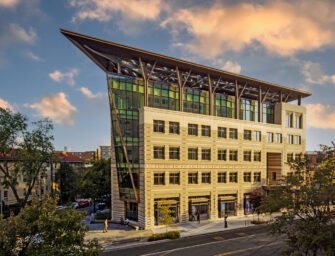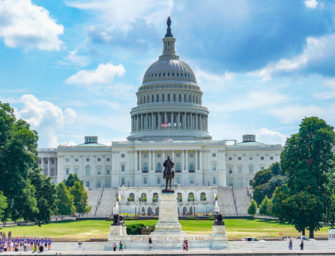Margaret Leinen: Reflections Upon My Presidency of the AGU
After two years as President of the American Geophysical Union, from 2014 to 2016, Margaret Leinen, Vice Chancellor for Marine Science at UC San Diego and Director of Scripps Institution of Oceanography, looks back upon her tenure leading the organization during a period of extended growth and evolution.
American Geophysical Union (AGU): How did your tenure as President-elect of AGU prepare you to assume the role of President?
Margaret Leinen (ML): The AGU President-elect is involved in every aspect of AGU governance. She chairs the AGU Council – which has representatives from all the sections, focus groups and committees of AGU, as well as student and early career members. Through chairing the council I was able to get to know leadership of AGU section and focus groups, to hear more about how the groups operate and learn in depth about the activities they sponsor at the Fall Meeting and other AGU events. The President-elect is also a member of the AGU board and I became deeply involved with the President, past President, and the Executive Director/CEO in setting the agenda for the board meetings, prioritizing issues as well as learning more about the business side of AGU.
AGU: Given what you had learned as President-elect, what were some of goals that you hoped to address during your tenure as President?
ML: One of the things I had been focused upon for quite a while was how to make our meetings more accessible to our diverse, national and international membership. For example, how could we make activities at the Fall Meeting more open to our members who are not able to join us in person? And, for those who do attend, what could we do to make it easier to navigate the meeting, to find others who are interested in similar research topics and disciplines, to find others who share interests in other topics like field work, teaching, communicating with the public? We also wanted to devote more resources to live and on-demand streaming of the Union. To address these challenges, at the beginning of my presidency we established a special Meetings Task Force to develop strategies to create greater accessibility for our Fall Meeting as well as look at the roles of the other meetings we sponsor.
I also wanted to highlight the climate for women and people of color in our field – and the ways in which harassment/bullying/unequal treatment work against our ability to do science. In response, we’ve had two town hall meetings on this topic at the Fall Meeting and AGU is working toward establishing a program that is focused on scientific ethics, inclusion, and enhancing diversity.
The AGU Centennial, in 2019, was another priority during my presidency. In 2014 we set up a Centennial Task Force that developed ideas for the Centennial and at the last AGU Board meeting we approved a budget that will allow us to use the Centennial as a way to convey the excitement of Earth and space sciences and the dramatic achievements of our field over the last century.
AGU: What has been your role in leading the renovation of AGU’s headquarters; in particular the effort to attain “net zero” in the redesign process?
ML: When AGU CEO and Executive Director Chris McEntee brought the AGU Board an assessment of the condition of the building, and we began to think about more than making the building a fully functional work space for AGU employees that would also serve the needs our membership. We began to consider the possibility that the building could serve as a vibrant example of our commitment to energy efficiency as well as a center for outreach on Earth and space science. Following some significant discussions with our members, we initiated a two-year long process that culminated in the approval of a budget at the December 2016 Board meeting that would allow the building to meet – as closely as possible – net zero goals, as well as allow for new outreach space to help members and visitors better understand Earth and space science as well as demonstrate the net zero technologies.
AGU: AGU is a remarkably diverse organization – representing more than 60,000 scientists from 143 countries. What were some of the methods that you employed to encourage and strengthen this diversity in background, career stage, and area of expertise?
ML: Forty percent of our membership is international with many of the authors of AGU journals also based outside of the U.S. While, we have an International Secretary who focuses on this topic, I wanted to reach out personally to international members. For example, I visited China – where local AGU members include representatives of the national academy of science, government agencies, and universities. We subsequently set up significant resources for Chinese scientists to be active in AGU, to ease barriers to publishing in AGU journals. Another example is that we are strengthening our partnerships with our Japanese colleagues. This is very important as the second largest contingent of AGU members reside in Japan. In May of 2017, we will be jointly sponsoring a meeting with the Japanese Geophysical Union (JpGU). In preparation for this JpGU has increased the percentage of talks in English at their meeting to more than 50 and U.S. attendance has climbed significantly. We have also been very active in the European Geophysical Union (EGU) with our members both attending their annual meeting and sponsoring joint sessions. This includes the popular “Great Debates” – at the AGU and EGU meetings – which take on the same topic at both meetings. This past year, AGU CEO and Executive Director Chris McEntee and Chief Operating Officer Frank Krause also attended The International Union of Geodesy and Geophysics (IUGG) meeting in South Africa which provided a special opportunity to connect with many of our African colleagues and members.
All of our committees also have early career members and most have student members. We also try to engage early members through our blogs, many of which are written by early career scientists. We also have very strong student and early career scientist participation in our Sharing Science network, one of our signature programs that seeks to give our members the tools to become more effective science communicators and improve outreach to businesses, government, and other non-affiliated scientists. At our Fall Meeting, we have our Student Breakfast as well as other special receptions for students, women, and people of color in the geosciences that provide an environment for individuals to connect and bring issues of import to AGU.
AGU: Looking to the future – with a major shift in Congress/the Presidential administration on the horizon, ever accelerating technical and scientific advancements, an evolving and increasingly international membership base – what do you see as some of the greatest challenges and opportunities facing AGU both in the short and long term?
ML: I think any change of administration means that are new people, new points of view as well as some reorganization and reprioritization. I saw this when I was at the National Science Foundation during the transition from Clinton to Bush. We also saw it from Bush to Obama, and we’ll see it again now. It’s part of the peaceful transition of power.
At this moment, I think that AGU has been called upon to cut through the static to help our membership understand which comments/opinions/statements of action made during the campaign will actually play out within the new administration. I also think that AGU has an important role in talking to the leadership in the House, Senate, agency transition teams, and at our sister science and policy organizations to stress the importance of Earth and space science, the reality of human-induced climate change, and the need for the U.S. to move towards taking a more active role in pursuing sustainable energy.
We have also been working with House and Senate staff to ensure that they have access to – and make use of – respected scientific experts. And, I think this is an area where AGU has been a strong voice for Earth and space science, serving our membership well.
AGU: Finally, are there any unique experiences – meetings, anecdotes, conversations, etc. – that are etched into your memory from your time as President?
ML: One of those was my visit to China. The opportunity to visit so many universities and locations, to meet with the head of the Chinese Academy of Science, leadership of agencies within the Chinese government, and to see the vibrant, ongoing relationships they were building – was truly fantastic.
One of the other things that’s also been a real thrill has been the ability to meet some of the high-profile speakers we’ve had, including former NOAA Administrator Kathryn Sullivan, and former Interior Secretary Sally Jewell. I will never forget interviewing Elon Musk in front of 4,000 members of the AGU at the Fall Meeting or introducing California Governor Jerry Brown this past year. And it was an honor to meet with the Prince of Monaco – the leader of a nation who is passionate about preserving the oceans and combating climate change – who took the time to come to the AGU meeting. It was just extraordinary.



A great story thank you. I enjoyed listening to her speak while online attending AGU2016. She was a great spokesperson and leader for the organization. I hope this organization makes it through this political change in America.- I’m a Canadian scientist and a fan.
Thank you, Margaret, for your outstanding service to, and leadership of, AGU.
And every best wish for your continued university leadership. Lou